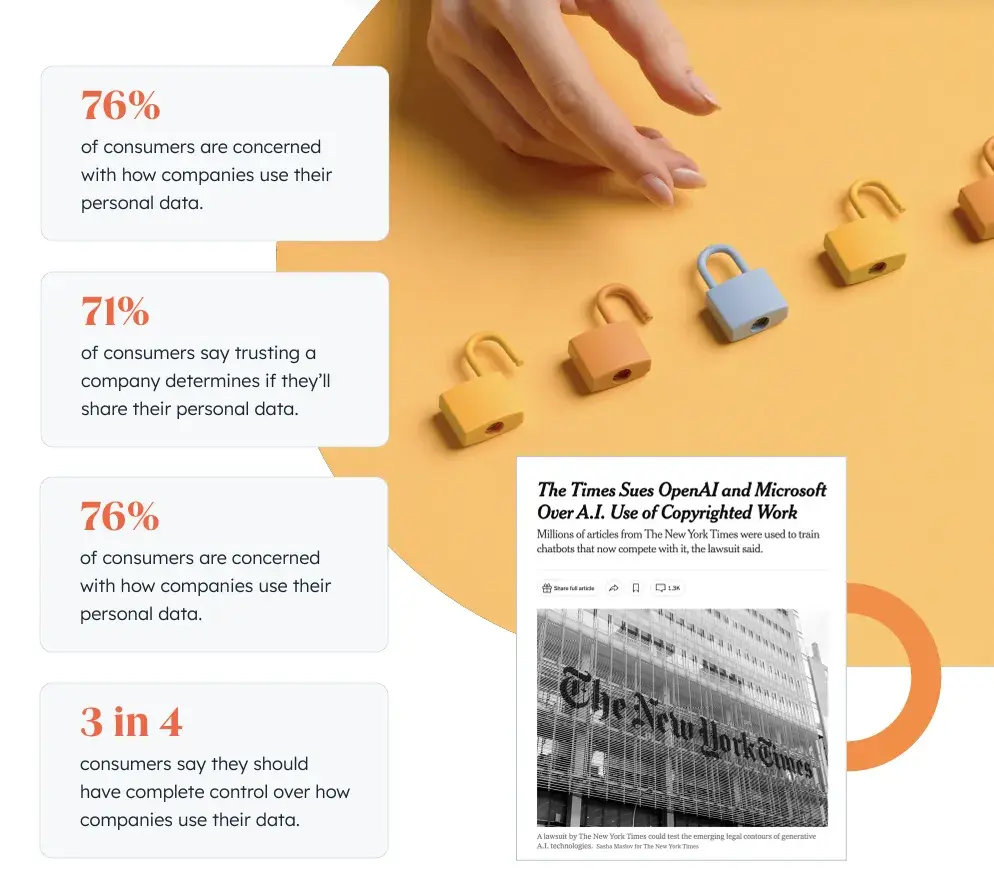In this post, I’ll cover everything you need to know about demographic questions and how to ask them well. I’ve also compiled 15 examples you can steal for your next survey.
Table of Contents
- Examples of Demographic Survey Questions
- What is a demographic?
- Challenges With Getting and Using Demographics
- Benefits of Demographic Questions in Surveys
- The Power of Demographics
What is a demographic?
A demographic is a measurable characteristic that describes a person or group. Common demographics include:
- Age
- Gender
- Ethnicity
- Household Income
- Religion
- Location
- Education Level

Demographic data is essential for understanding your customer base. By piecing together many demographic (and behavioral) data points, you can segment your customer base into meaningful groups.
Understanding the traits and qualities of your customer base helps you create a clearer picture of the types of customers you serve. That way, you can personalize messaging and offer products and services that genuinely meet their needs.
This insight is gold for your marketing, product, sales, and service teams. But gathering data that’s valuable doesn’t come without challenges.
Challenges With Getting and Using Demographics
Collecting demographic information sounds simple, but it's a sensitive practice that raises privacy concerns and requires walking a fine line between inquiring about personal details and being invasive.
I wouldn’t walk up to a stranger on the street and say, “Hey, what ethnicity are you?” So, what makes it okay to do that in a survey? Well, that’s the tricky part. Asking demographic questions requires respect and transparency, but the results are invaluable when done right.
Navigating Expectations of Privacy
Data privacy is a deal-breaker for many people, and it’s only getting more important over time. I reviewed our 2024 Consumer Trends Report, and the following privacy stats jumped out at me:
- 75% of respondents believe that data privacy is a basic human right.
- 76% of respondents are concerned about how companies use their data.
- 71% of respondents say trust in a company determines whether they’ll share information.
- 3 out of 4 respondents believe they should have complete control over their data use.

I don’t even like giving out my phone number or email unless I have to, and I’m sure I’m not alone in that sentiment. If I’m going to give away my demographic data to a brand, they must earn my trust first.
Avoiding Stereotypes
Demographics are facts. They are the measurable characteristics of a person or group that help you segment your customer base and craft personalized messaging. Stereotypes, on the other hand, are overgeneralized traits assigned to groups, often rooted in bias, not data.
Here’s the difference:
- Demographic: 35% of our customers are Gen Z.
- Stereotype: Gen Z doesn’t want to work.
It’s easy to blur the line between demographics and stereotypes. That’s why it’s important to ask respectful questions and avoid making unfair assumptions when interpreting the data.
Using Demographics for Targeted Messaging
Demographics help you understand your customers’ needs based on real facts, not generalizations. That means you can craft marketing messaging that actually resonates.
For example, I run a musical instrument backline rental company, which means I rent amps, guitars, and drums for artists who perform in my city. At first, I thought I would craft my messaging towards the players, so I hyped up the technical specs, tonal quality, and vintage lore.
However, I quickly realized that the players weren’t the ones finding my website and making rental requests. It was the managers. And, they couldn't care less about vintage tubes and nitrocellulose finishes. They just wanted to know about reliability, availability, brand names, and if I could deliver on time.
This insight completely changed how I approached my marketing messaging. After rewriting the copy on my site to highlight logistics, flexibility, and fast service, I’ve seen an uptick in rental requests.
Unlike stereotypes, which rely on lazy assumptions, using demographics well requires effort. You’ve got to ask the right questions, analyze the data, and use it to build a buyer persona that reflects the people who are interacting with your business.
Pro tip: Want an easier way to crunch the numbers on your survey responses? Check out HubSpot’s Reporting Dashboard to create custom dashboards and turn your data into actionable insights.
Building Trust to Collect Demographic Information
I’m pretty skeptical about giving away my personal information. I’ll only share it with brands I know and trust, and I believe that a company's treatment of my personal data indicates how they view me as a customer. As it turns out, 81% of people agree with me.
The risks of sharing personal data online are very real. Plenty of bad actors are willing to sell your data without your consent, and all it takes is one breach. It’s happened to me, and if you’ve ever received a spam call or robocall, it’s probably happened to you, too.
Recently, I received an email from Ring, the doorbell camera company, thanking me for signing up for an account and asking me to verify my email address. The thing is, I don’t own a Ring doorbell, and I definitely didn’t sign up for an account. I promptly contacted their support line, and days later, I still haven’t heard back.
Now, this probably isn’t Ring’s fault. Someone probably pulled my email off some dark web list and tried to use it to make an account. Why? I don’t know. But Ring's lack of responsiveness and transparency killed my confidence. I won’t willingly give them my personal data anytime soon, let alone buy a doorbell cam.
That’s why asking for demographic information isn’t something you can rush. You’ve got to earn trust with your customers over time, but I believe it's worth the effort. Done right, you will forge strong customer relationships and gain insights that lead to better products, messaging, and customer experience overall.
Want to learn more about demographics and market research? Grab our free Market Research Templates kit to map your audience like a pro.
Using demographic questions can help you better understand your audience, improve communication strategies, and maximize the effectiveness of your marketing budget. Below, I’ll review common demographic questions, their importance, and how to ask them.
1. Gender
Gender is a fundamental demographic, but asking about it requires careful handling. While this information is valuable, it shouldn‘t come at the expense of your customers’ comfort.
Avoid using the word “sex,” and always include inclusive options and a “prefer not to say” option.
Example: “What gender do you identify as?”
- Male
- Female
- Non-Binary
- _________ (short answer space)
- Prefer not to say
2. Age
Age is a standard demographic question that should be included in every demographic survey. Knowing your audience’s age reveals many characteristics that can aid your targeting and segmentation.
The best way to ask this question is in a multiple-choice format that uses age ranges for each answer. Some customers may feel uncomfortable revealing their exact age, so this structure allows them to participate while protecting their personal information.
Example: “How old are you?”
- Under 18
- 18-24
- 25-34
- 35-44
- 45-54
- 55-64
- 65+
- Prefer not to say
Pro tip: Age data reveals which generations your respondents belong to, which may be of particular interest to your marketing and strategy teams.
3. Ethnicity
Understanding your audience’s ethnicity helps paint a picture of their cultural backgrounds, social influences, and values. This information is valuable in targeting, but it’s essential to approach this demographic question with sensitivity and inclusivity in mind.
Example: “How would you describe your ethnicity? (Select all that apply.)”
- White/Caucasian
- Black or African-American
- Hispanic or Latino
- Asian
- Middle Eastern
- Native American or Alaska Native
- Native Hawaiian or Pacific Islander
- Other: ________
- Prefer not to say
Pro tip: Ensure this is a multi-select question, not just a multiple-choice question where respondents can only pick one option. This includes bi- and mixed-race people and will enrich your data.
4. Location
Audience location data is a core demographic question that reveals regional trends and attitudes and can help you identify market expansion opportunities. The level of locational granularity you require will depend on your business. Local businesses will want to know the cities and towns people are from, while global companies are more likely to be concerned with the country and/or state of residence.
Example: “Where is your current place of residence?”
- North America
- South America
- Europe
- Africa
- Asia
- Australia
- Middle East
- Other: ______
- Prefer not to say
5. Education Level
Your audience’s educational background can reveal insights about how they think, make decisions, and the types of products and services they value. Understanding their highest level of education helps build a comprehensive buyer persona.
Include options for trades and apprenticeships. Some of your customers may have chosen a different career path outside of traditional academia, and it's essential to be inclusive of those people.
Example: “What is the highest level of education you have completed?”
- Some High School
- High School Graduate or GED
- Some College
- Bachelor’s Degree
- Master's Degree
- Doctorate (Ph.D., Ed.D., etc.)
- Trade or Vocational School
- Prefer not to say
6. Marital Status
Marital status is an informative demographic question that can reveal much about your respondent's priorities and needs. It’s beneficial for targeting if your product is related to family life or might require joint decision-making based on budgeting or shared experiences.
Example: “What is your marital status?”
- Single
- In a domestic partnership
- Married
- Divorced
- Widowed
- Prefer not to say
7. Family and Dependents
Asking about marital status reveals a lot about your respondents, but supplementing that with information about family and dependents paints a fuller picture of their needs, behaviors, pain points, and values.
Example: “How many children or dependents do you have?”
- None
- 1
- 2
- 3
- 4+
- Prefer not to say
8. Living Status
Your customers’ living situations can tell you a lot about their mobility, lifestyle, and spending priorities. For example, homeowners are typically more settled and have longer-term needs compared to renters.
Example: “Which of the following describes your living situation?”
- Homeowner
- Renter
- Living with parents/family
- Temporary housing
- Prefer not to say
9. Annual Household Income
Annual household income helps you understand your customers’ buying power. This figure is a sum of the combined earnings of everyone living in a single residence, like spouses and family members.
For many, income can be a sensitive topic, so I recommend including a “Prefer not to say” option to respect privacy.
Example: “What is your annual household income?”
- Less than $25,000
- $25,000 - $49,999
- $50,000 - $99,999
- $100,000 - $199,999
- $200,000 or more
- Prefer not to say
Pro tip: Test out different income ranges depending on your target market. If the range is too wide, the data isn’t as valuable, and too narrow an income range can feel a little intrusive.
10. Employment Status
Employment status contextualizes your audience's financial situation, lifestyle, and needs. Paired with income data, it can reveal more information about purchasing power and help you personalize your messaging.
For example, I’m a self-employed individual with special needs for software and tax services. Apparently, online advertisers are intimately aware of this (I’m getting a lot of TurboTax Ads).
Example: “What is your current employment status?”
- Full-time
- Part-time
- Contract or temporary
- Self-employed
- Retired
- Unemployed
- Unable to work
- Prefer not to say
11. Voting Status
Asking about your customers’ voter registration status can give you a sense of their level of civic engagement. People who are registered to vote are more likely to be engaged in their communities and be responsive to political or social messaging.
This is a sensitive topic, so I recommend treading carefully and omitting it unless you stand to gain invaluable insights that directly support your goals.
Example: “Are you registered to vote in ____?”
- Yes
- No
- Prefer not to say
12. Political Views
Political affiliation is one of the most sensitive demographic questions you can ask. However, it can reveal much about your audience's values and greatly inform your messaging strategy.
If your brand touches on social issues and cause-based marketing, this question can be valuable for crafting messages that resonate with your customers. If not, I recommend handling this question with care and always making it optional.
Example: “Which of the following groups do your political views align with?”
- Democrat
- Republican
- Independent
- Other: _______
- Don’t know
- Prefer not to say
13. Language
Language is an essential demographic question for obvious reasons. You can’t speak to your customers if there’s a language barrier.
Beyond that, understanding your audiences’ language(s) reveals important cultural details that can indicate values, preferences, and communication preferences.
Example: “Which languages do you speak fluently? (Check all that apply)”
- English
- Spanish
- Portuguese
- French
- Mandarin
- Arabic
- Other: _____
14. Place of Birth
Place of birth offers context to your audience’s background, especially when paired with location and language data.
For example, two people might live in the U.S., but someone born in China will likely have different needs, values, preferences, and expectations than someone born and raised in the States. Without place of birth data, these details sometimes fall through the cracks.
Example: “Where were you born?”
- North America
- Central America
- South America
- Europe
- Africa
- Asia
- Australia
- Pacific Islands
- Middle East
- Caribbean Islands
- Other: _____
- Prefer not to say
15. Religion
Last but not least in the “tread lightly” category of demographic questions is religion. Religious affiliation reveals powerful insights into your audiences' values, beliefs, and lifestyle choices, which helps you craft messaging that resonates.
I recommend only including it if you must, and as always, make it optional.
Example: “What is your religious affiliation, if any?”
- Christianity
- Judaism
- Islam
- Hinduism
- Buddhism
- None
- Other: _____
- Prefer not to say
Benefits of Demographic Questions in Surveys
Demographic questions help you develop accurate buyer personas: detailed profiles that power targeted marketing campaigns, effective sales tactics, and support experiences that delight customers.
These personas reflect your customers’ backgrounds, needs, and pain points, giving you a competitive edge when connecting with them. However, the benefits of demographic information aren’t just for marketing teams.
When I worked at HubSpot Support, knowing our personas inside and out helped me better understand customers' needs, resulting in smoother calls and increased satisfaction. For example, one type of persona I often worked with was the IT professional, who was sharp, technical, and confident in troubleshooting. When I got on the phone with a techy customer, I knew I could reliably ask them to “inspect element” on a page without inciting panic.
Here are a few key benefits of using demographic questions in your surveys:
1. Better buyer personas.
Creating a buyer persona will help you understand customers’ habits, needs, pain points, and motivations. With these insights, you can:
- Improve the customer experience at key touchpoints.
- Create an effective customer journey map.
- Tailor your marketing messaging so it resonates.
The more accurate your buyer personas are, the better you can understand and serve your customers' needs. These insights will help you develop new products your customers want, improve service to make their lives easier, and personalize your marketing messaging so it strikes a chord every time.
2. Better understanding of business trends.
Demographic data brings another level of insight to your surveys. Instead of just seeing what’s happening, demographic data can give you the who and the why.
For example, if you notice a dip in sales, diving into the demographic data might show that Gen Z customers in the Northeast are falling off. These insights let you adjust your strategies surgically, saving time and money.
3. Better understanding of your target audience.
Demographic surveys provide a deeper understanding of your customers. If you plan to launch a new product or service, the demographics of your existing customer base will help you target your efforts to those most likely to respond.
Demographic information can also reveal new opportunities.
HubSpot’s 2024 Consumer Trends Report showed that while 55% of respondents are tightening their budgets, that number jumps to 68% for Baby Boomers. If you’ve done your demographics homework and discovered that a decent chunk of your customers are Boomers, that could be the cue to adjust your product's positioning and pricing.
4. Enhanced customer engagement.
Understanding your audience’s demographics can help you create more relevant content that people want to engage with. That could mean better social captions, blog posts that customers find genuinely helpful, personalized offers, or emails that don’t get immediately binned. The result? Increased customer engagement and more sales.
As a former HubSpot support rep, I have to give you a support-related example:
HubSpot’s 2024 Consumer Trends Report found that Gen Z preferred sending a direct message to receive support, whereas Boomers vastly preferred calling in. No surprises there.
If your demographics show that most of your customers are Gen Z, investing in an omni-channel customer support solution with powerful messaging features could delight your customers and your support team.

Now that we understand the importance of demographic survey questions, the next step is to put them to work. Using a Customer Feedback Software tool like ours, you can:
- Build surveys with demographic questions tailored to your audience.
- Run customer feedback surveys to gather key insights on how customers view your brand.
- Analyze customer feedback and data with customizable dashboards.
- Share insights across teams so that everyone’s on the same page.
The Power of Demographics
Demographics can help you understand your customers and how best to approach them with your products and services. The next time you reach out to your customers with a survey, I encourage you to include some of these demographic examples. Ultimately, I’ve found this information crucial in meeting customers where they are with the messages they want to hear.
Editor's note: This post was originally published in July 2024 and has been updated for comprehensiveness.
Survey Creation



![16 best free online survey makers and tools [+ recommendations]](https://53.fs1.hubspotusercontent-na1.net/hubfs/53/free-online-survey-maker-1-20251028-2654831.webp)

![How to conduct survey analysis like a data pro [all my tips + secrets]](https://53.fs1.hubspotusercontent-na1.net/hubfs/53/survey-results-1-20241031-6355381.webp)
![Leading questions: What they are & why they matter [+ Examples]](https://53.fs1.hubspotusercontent-na1.net/hubfs/53/leading-questions-hero.webp)
![How long should a survey be? The ideal survey length [New data]](https://53.fs1.hubspotusercontent-na1.net/hubfs/53/how%20long%20should%20a%20survey%20be_featured.png)




![What Is a Likert Scale? [Examples & Templates]](https://53.fs1.hubspotusercontent-na1.net/hubfs/53/likert-scale-1-20241031-1487623.webp)